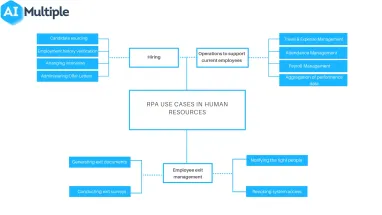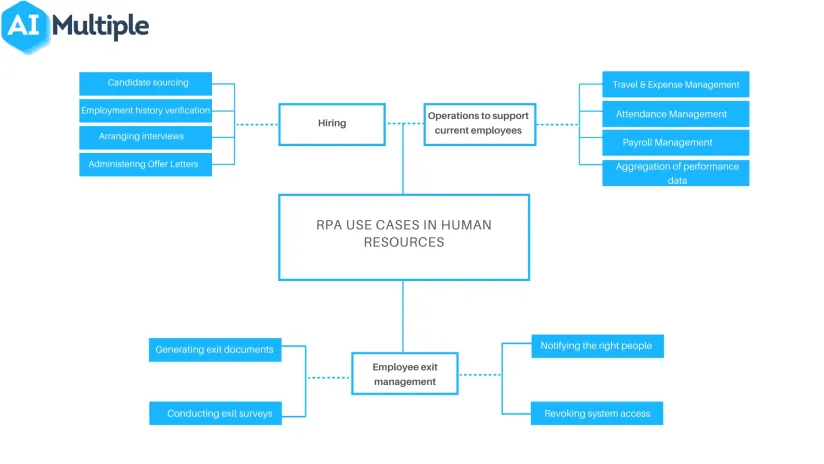Human resources processes include repetitive tasks that can be automated with RPA. According to PwC’s 2020 HR technology survey, 45% of HR leaders planned to invest in hyperautomation or Robotic Process Automation (RPA) technology ahead of the 12-24 months.
Identifying use cases that will yield the greatest benefits is the first step of RPA implementation. Below, you can see all applications and benefits of RPA in the HR department:
What does RPA mean for human resources (HR) department?
According to Gallup’s State of the Global Workplace report, 87% of employees worldwide are not engaged or actively disengaged at work, which costs approximately $7 trillion due to lost productivity. Though it is HR’s job to keep employees engaged, it is not always possible because most HR teams need to complete repetitive tasks that can be automated.
RPA technology can free up an HR department to focus on
- boosting employee productivity by effective performance management
- keeping employees engaged
- improving business’ brand in a competitive job market
- taking data driven actions thanks to people analytics
Benefits of RPA for HR
We mentioned that RPA can allow HR departments to focus on value added activities. In addition, RPA can improve how people operations are run.
Operational Efficiency
Accuracy
RPA improves the accuracy of data integration and validation processes which are highly error-prone when handled by humans.
Faster HR operations
The most problematic issue about back-office processes is they require labor hours, which holds HR professionals away from high-value tasks and decreases productivity. Thanks to RPA, automation of processes decreases the labor hours spent on tasks and frees the HR team, improving overall efficiency.
Employee Satisfaction
According to 2020 Retention report, more than 40M employees in the USA left their job voluntarily in 2019, and the total cost of voluntary employee turnover exceeded $630M. Automating tasks and freeing employees from dull tasks improves employee satisfaction, which reduces employee churns directly, and turnover cost indirectly.
Streamlining talent acquisition
RPA bots help businesses keep track of candidates’ profiles organized so that HR professionals can streamline the whole process. They can also achieve the same result by relying on Applicant Tracking Systems.
These are RPA benefits related to the HR department, yet all benefits are not limited to this list. If you want to learn all other RPA benefits for your business, please check our related article.
RPA use cases in Human Resources (HR)
Hiring
1. Onboarding automation
During the onboarding process of new hires, HR professionals should handle tasks such as creating a new user account and email address, enabling access to required files, applications, and IT equipment. To do all these tasks, they need to integrate data from several systems.
RPA can help streamline this process. RPA bots can make rule-guided decisions during onboarding. Some example decisions bots can make are
- assigning credentials to the new employee
- sending relevant onboarding documents to the new employees
2. Candidate sourcing
During recruitment, CV screening and candidate shortlisting can be the most time-consuming tasks. RPA bots can gather and screen resumes and collect online application forms. Then they can compare the candidate data against all relevant job requirements with pre-defined rules or RPA plugins with machine learning capabilities. However, companies need to test and evaluate such tools and avoid AI bias in their recruitment.
3. Employment history verification
Employee history verification requires cross-checking interviewed candidates’ data against different sources. Using an RPA bot, companies can gather required employee history information from the input sources and cross-check information with backend databases. Then the bot creates reports without any human intervention and can flag candidates where it runs into issues in verifying their employment history.
4. Arranging interviews
Numerous interviews need to be arranged between the hiring team and the candidate. Calendar based collaboration software such as calendly or conversational AI systems like X.AI can help companies arrange interviews with ease. Similar solutions can also be deployed with the help of RPA software and APIs but this is not a common domain for RPA solutions.
5. Administer Offer Letters
Creating and sending offer letters to new hires that comply with different sets of regulations (company’s internal policies, laws and regulations, etc.) are HR professionals’ job. To do this, they may need to gather information from several systems and databases yet, it is a time consuming process.
RPA bots can gather all the necessary information, create the offer letter, send it, and eventually monitor the returned documents. Along with making the whole process error-free, RPA bots can also process offer letters faster than humans. For instance, SAP Intelligent RPA reduced the offer letter generation time to 1 minute from 15 minutes.
Operations to support current employees
6. Travel & Expense Management
Another manual task HR or finance specialists deal with is the processing of travel and expenses. Issues such as late submissions, missing receipts, out-of-policy-spends, and unclear expense claim reasons may arise during manual processing, which may lead to compliance risks and reduce employee satisfaction.
With the help of hyperautomation, OCR enabled RPA can collect travel expense receipts of employees, extract required data from receipts, and cross-check individual expenses against company rules and external expenditure regulations. However, there also dedicated, end-to-end expense management systems and large companies may choose to rely on them for T&E management.
7. Attendance Management
Employee attendance tracking is a byproduct of the first industrial revolution and we do not recommend it for most modern enterprises. However, industries like physical retail require attendance management. There are also cases such as event attendance tracking where attendance management may be beneficial. Attendance management involves variety of tasks including
- managing attendance (e.g. for visitors or contractors for security reasons). RPA bots can
- cross-check absentee reports against time logged in the corporate network
- alert HR when the business confronts major absenteeism that disrupts workflow, and workforce reallocation is necessary.
- events and training planning
- processing other administrative tasks such as invoices, payroll and managing staff attendance based on attendance reports.
8. Payroll Management
Payroll management involves mostly data entry tasks that should be done accurately. Mistakes made during payroll management directly reduces employee satisfaction and productivity. Bots reduce this risk. Since bots also automate and decrease the time spent on payrolls, businesses will avoid delayed payments as well.
9. Aggregating data for performance reviews
Employee performance can be scattered across different systems. Aggregating it can be valuable to provide a holistic perspective on employee performance.
Employee exit management
Similar to on-boarding, RPA can be used to improve employee exit experience. During employee exits, HR team deals with various tasks that can be automated using RPA. Some tasks RPA can automate during employee exits are
- generating exit documents,
- conducting exit surveys,
- notifying the right people,
- revoking system access,
- collecting company assets,
- processing final payments.
Skipping any of these tasks may result in multiple audit flags.
Feel free to read our article on HR technology trends to learn about other emerging technologies that shape the future of HR. If you are looking for an RPA software, don’t hesitate to check our RPA software vendor list or contact us:



Comments
Your email address will not be published. All fields are required.